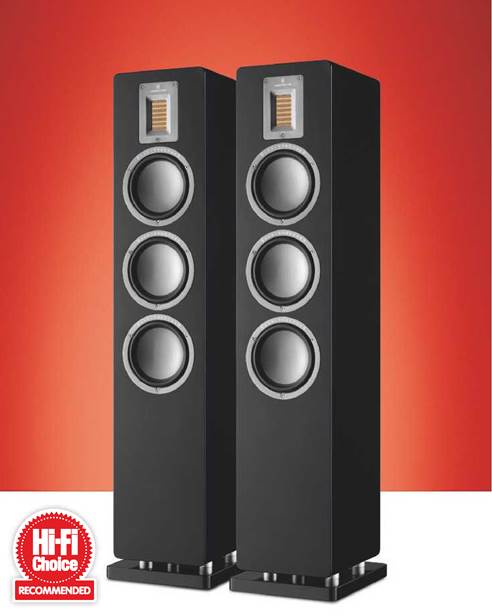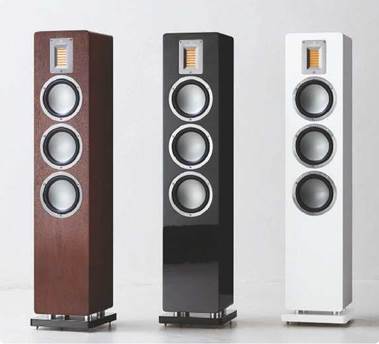The Danes love building speakers. Audiovector, for example, is based in the capital city of Copenhagen and is ramping up to conquer the global market—ideally with the Audiovector QR5. Tested at 3,000 euros per pair.
By Andreas Günther

DETAILS
| Product | Audiovector QR5 |
| Origin | Denmark |
| Type | 3-way floorstanding loudspeaker |
| Weight | 23 kg |
| Dimensions (WxHxD) | 210 x 1,057 x 270 mm |
| Features | – 1x AMT ribbon tweeter |
| – 1x 152mm aluminium sandwich midrange driver | |
| – 2x 152mm aluminium sandwich bass drivers | |
| – Quoted sensitivity: 91dB/1W/1m (4 ohm) | |
| Distributor | Audiovector |
| Telephone | +45 3539 6060 |
| Website | audiovector.com |
The two Klifoths recently moved their company. Father Ole and son Mads now work 20 minutes from downtown Copenhagen. Previously, they were located right by the harbor, but the company outgrew the charming premises.
Is this important to know? Well, it shows that Audiovector is doing well. Sales numbers are rising, and international demand is blooming. The Klifoths have just secured a new distributor in Germany. They’re ready to accelerate. Danish speakers are still highly regarded worldwide.
But aren’t they usually expensive? Not necessarily. We chose an ideal mix of delicacy and fair price from the Audiovector catalog. The QR5 is the largest speaker in the QR series, beautifully crafted, and still affordable at 3,000 euros per pair. Especially since it includes a genuine Air Motion Transformer in the highs, handcrafted at Audiovector. The ultra-thin membrane is folded like a tiny bellows, all according to the design of the great inventor Oscar Heil. It’s supposed to perform cleanly up to 45 kilohertz.
Only a few master this art. In Germany, Elac has its own AMT production and uses it only in their high-end series. Audiovector takes perhaps greater effort, setting their foil driver in a large frame of solid aluminum. They also add a metal mesh in front, which not only protects the delicate membrane but also acts as an “S-Stop” filter. Similar to a pop filter in front of a microphone, it prevents plosive and sibilant sounds from reaching the ears.
The bass is outsourced, or rather custom-made. Scan Speak manufactures the drivers to customer specifications, and no other manufacturer can access this pool. The eyes delight in a fine frame of sandblasted aluminum. The membrane consists of a three-layer sandwich with visible aluminum as the top layer—everything else remains a company secret. Just this much: Audiovector goes to great lengths to avoid eddy currents. This is almost an obsession of chief developer and founder Ole Klifoth. Nothing is too expensive for him, so at the center of the drive magnet lies a solid block of titanium.
CLASSIC DIVISION OF LABOR
Looking at the overall construction, one might wonder: Three identical 15 cm membranes in diameter, plus an Air Motion Transformer on top. How are the work areas divided? The tweeter kicks in at 3 kilohertz, the driver below is defined as a midrange, and below 400 hertz, the two basses work in parallel. So, a classic three-way setup. The reflex energy is directed toward the floor, making placement easier. Everything is designed for maximum linearity. Our measurement lab gives the Audiovector top marks. Only the deep bass is slightly boosted, which dissipates in a well-damped listening room.
The tweeter drew us to a legendary recording: Herbert von Karajan conducting Jean Sibelius’ Fifth Symphony (Deutsche Grammophon). You can tell what a sound magician the Salzburg-born conductor was. Bland speakers don’t capture this sound rush; it feels one-dimensional. But the QR5 had the sensitivity. It showcased the unique art of its tweeter. It was a panorama of luxury class—wide, open, perfectly layered, yet confident and stress-free. It also handled dynamic details delicately. Unbelievable how consistently Karajan had the Berlin Philharmonic play pianissimo—during the vinyl era. That must have almost pushed the limits of rumble distance. Then the grand outburst in the finale: The distinctive theme is hurled toward the listener by all the brass instruments. The QR5 displayed the full splendor—streaming finely and dynamically from the speaker axis. Truly the great sound impact. We were also delighted that the drivers were apparently perfectly matched—cohesive, elegant, and human.
FINE DELICACIES FROM THE STUDIO
For test music from the pop/rock genre, we streamed The National. Their latest album, “I Am Easy to Find,” leads the download charts on Qobuz—and rightly so. The songs are melodic, and the mix is fantastic. Finally, a high-end offering from a popular band. The Audiovector QR5 immediately showed the recording room conditions. It sounded precisely balanced, very analytical, but never cold. The bass descended impressively, sounding almost growly and edgy. It followed the phrasing and musical intention of the band superbly. This is how the high-end class should sound!
MEASUREMENT LAB
On-axis, the QR5 shows a straight frequency response with a slight bass boost; laterally, it radiates sound homogeneously (blue), while measured 10 degrees above the tweeter, slight discolorations occur. With a peak level of 109 dB and a -6 dB point of 38 Hz, the QR5 offers a strong foundation. A nominal impedance of 4 ohms and an AUDIO score of 55 make the speaker amplifier-friendly.

HOW IT COMPARES
The QR5 would have shared many qualities with the victorious KEF R5 and even bettering it for ultimate treble quality, though the KEF costs £ less. For a sprightlier presentation, Spendor’s compact, two-way A4 is well worth a listen, while if preferences err more towards a warm and expansive presentation, Amphion’s Argon 3LS has the answer. But as an all-rounder, the QR5 is hard to beat.

VERDICT
Denmark must be the ideal breeding ground for speaker manufacturers. There are almost more companies here than in Germany, on a smaller area. Audiovector plays with the big leagues. The finish of the QR5 is perfect, the design classic. In addition, a luxury-class sound image—focused on analysis, yet human, transparent, and stress-resistant. The price doesn’t reflect this—it’s almost outrageously affordable.






